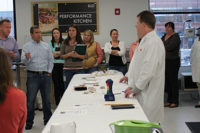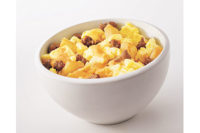Special Report
A sharper image for Hillshire Brands
After renewing its emphasis on meat-centric innovation, Hillshire Brands feels as though its direction is clear and its employees are tightly focused on its goals.
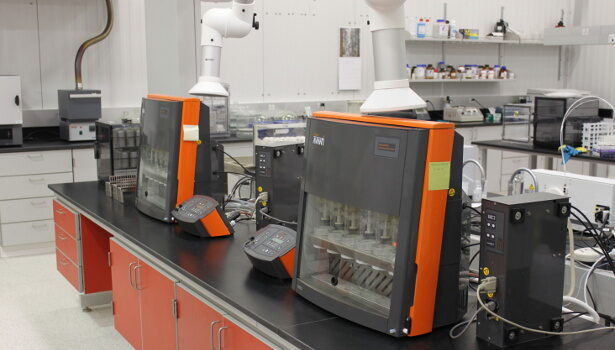
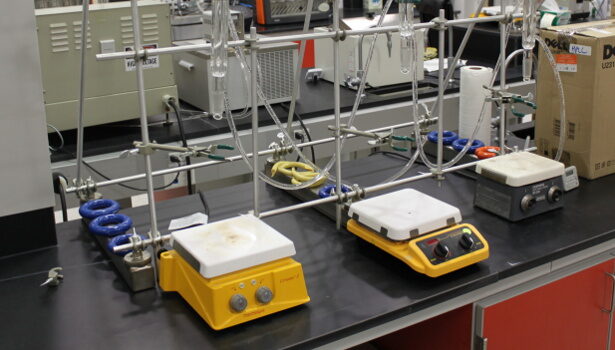
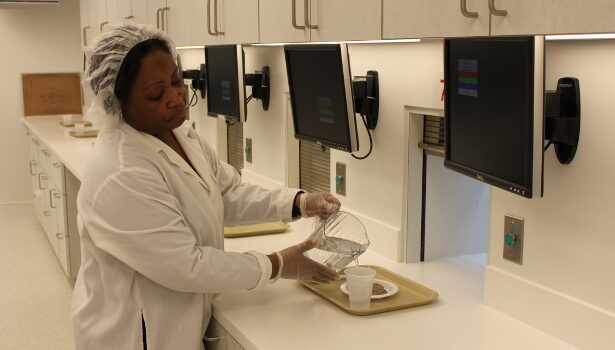




|
| George |
Andy Hanacek, editor-in-chief of The National Provisioner, visited Hillshire Brands’ innovation center in Downers Grove, Ill., in December 2012 to discuss the role of the facility and the R&D department in the “new world” of Hillshire Brands, with Jeff George, senior vice president of Research & Development. This is the first installment of what is expected to be a quarterly check-in by Hanacek with the Hillshire team as it maneuvers through its first full year removed from the days of Sara Lee Corp. What follows is the first conversation between Hanacek and George:
Hanacek: What do all the changes that have been going on it Hillshire — from the overall corporate changes, to the divestitures and the like — mean for the innovation center?
George: First, the innovation center is staying put, just to be clear, with the headquarters having moved downtown. And I think we’re excited that … over the course of two years, we’ve continued to get more clarity around our future. A couple of years ago there were a lot of unanswered questions around the future of our company, and … I think it’s really helped our company and our department too. So now we can really focus; we understand what we are; we have a clear mandate.
One of the most exciting things for me was with the announcement of Hillshire Brands’ vision, to be the most innovative meat-centric foods company in the U.S. Of all the different things we could have selected for the [primary focus], we said we’re going to build our future on innovation.
Hanacek: With that focus in mind, would you say that the innovation center has become a more integral piece of what Hillshire is doing than maybe it was in the past?
George: You see investment going back into this building, to where we’ve already made a lot of changes [since it was built in 2009]. It just goes to show the importance of it in the future. … We made the decision to commit to capability with this building, versus proximity [to headquarters] in this case. We’re committing to the capability that we’ve built here and are continuing to grow and build here. I think there is some value to proximity, because we had a lot of face-to-face interaction every day with our cross-functional counterparts [when headquarters was in Downers Grove, down the street from the innovation center]. But at the same time, we’ve built such great, strong, cross-functional relationships, and such a high level of trust, that I feel that we’re going to be able to retain that beyond the physical move.
Hanacek: So, let’s talk about some of those changes that are occurring here. The first one we looked at when we went on the tour was the old bakery area is now being changed into a chemical and analytical lab. Can you talk about some of the things that are going on in that lab?
George: We’ll have a lot of our chemistry and analytical capability here, and we’re actually going to be expanding that, so we’ll be able to measure some of the key attributes, like fat level, sodium levels. Sodium is very important to us. We have a lot of aggressive programs going on in sodium reduction. When we reduce sodium, it’s not just validating that the sodium is then reduced, but also that the other chemistry, the other attributes are maintained.
That lab had been housed in the [Downers Grove] headquarters building, and it has supported both the R&D center and all of our plants. It will continue to do those things, but even more efficiently and effectively in support of the innovation center, being located right next door. … It’s all about speed, iterations, and being better at innovation.
Hanacek: You’ve been partnering more with your outside seasonings suppliers. You have a supplier technician on site at all times. Can you talk about how that helps innovation?
George: A supplier’s technician does the seasoning, flavor building and the seasoning profile, and I think it really demonstrates a high degree of partnership — even higher than I’d experienced in the past. In the past, you’d develop strong partnerships, but yet there was a little bit of [a turf battle]. Actually having the person on site, working side by side with you is about as close an integration as you can have — and it’s built on a very strong win-win business partnership and high trusting collaborative relationship for us to be able to do that.
It delivers quality and speed. The key to innovation is iterations, just improving and improving each time. We’d do one or two rounds of optimization, and now we can do 10 rounds of optimization in that same timeframe [with this collaboration].
Hanacek: And you’re potentially expanding that lab in the future, into what was the former coffee division’s space?
George: Yes, we want to put even more emphasis on flavor and seasoning development, so we’re going to continue to expand the breadth of our partnerships, and potentially expand the space as well, since we’re a food company and taste is king. Flavor is king.
Hanacek: The final major renovation that we toured was the new consumer sensory area. Where was that before? Was it in the headquarters?
George: A smaller version of a consumer-sensory area was housed in the basement of the Downers Grove headquarters, but I think here we’re really able to expand our capability. So it’s not just a pick up and place; we’re actually building out what we can do here. … We’ll have the panelist windows and have the prep area right there, and all right on site.
Hanacek: So all the changes that have occurred through the corporate transition really have been a positive in your opinion, because of the renewed focus on innovation. Talk about how, from your perspective, that sharpened focus will help on the R&D side, being that innovative meat-centric company?
 George: In a big diversified company, with the size of our department, we would tend to be a mile wide and an inch deep. So by focusing the portfolio of our brands and our products, it’s enabling us to go much deeper on those products. … In the past — as I presented on our Investor Day [in 2012] — 70% of things we worked on in the R&D department were cost cutting or supporting brand maintenance, and only 30% was truly innovation; and of that 30%, the vast majority of that was line extensions, flavor additions. So the true transformational innovation was a very small percentage of what we did in the old world.
George: In a big diversified company, with the size of our department, we would tend to be a mile wide and an inch deep. So by focusing the portfolio of our brands and our products, it’s enabling us to go much deeper on those products. … In the past — as I presented on our Investor Day [in 2012] — 70% of things we worked on in the R&D department were cost cutting or supporting brand maintenance, and only 30% was truly innovation; and of that 30%, the vast majority of that was line extensions, flavor additions. So the true transformational innovation was a very small percentage of what we did in the old world.
By refocusing on a smaller set of brands and categories in meat, and then also by saying we’re going to be the most innovative meat-centric company in the U.S., it’s really changed our focus completely. … In fact, we’ve even started tracking our effort and have really transformed that. We’ve gone from [that Investor Day statistic], to now spending over 70% of the time in R&D on true innovation.
Furthermore, that’s resulted in a couple of improvements. One, in the cost-reduction area, we’ve really focused on getting the biggest bang for our buck, so we’ve kind of cut off the tail of all these sort of low-value, less incremental projects, and said, “OK, if we’re going to spend less time there, we’re going to really make it count.”
That’s created a tremendous amount of bandwidth in our department to put more effort on innovation. That, in turn, is helping us accelerate the projects we were working on through building capability. We’ve also freed up more time for people to start to come up with their own ideas — employee-generated ideas.
We’ve actually set aside one day per month, where we’ve cleared the decks — no meetings and no administrative things — for our people to work on projects of their choosing. So, if they have an idea that they’d like to work on, they have that time to partner up with teammates or use the facility to work on their projects.
We also have some structured brainstorming events where we bring in an outside speaker, or discuss trends or other idea stimulus. Employees can participate in the brainstorming sessions, come up with ideas and work on them for that day. And at the end of the day we have a really informal product cutting in the foodservice lab.
We’ve called it “Sharing New Opportunities to Win” — so it’s our SNOW Day.
Hanacek: Give me some examples of projects that have been done here, either on the cost-cutting side, or with the renewed focus on innovation — maybe one or two of your prime examples.
George: Starting with the innovation side, I can tell you of one innovation idea that came out of a program similar to the this employee-generated program that we’ve had historically — we just created the SNOW Day — is our new heat-fresh pouch. It’s a packaging pouch where our frozen products — sandwiches, snacks — right now require multiple steps and is rather complicated to reheat.
So we’ve launched a line of Ball Park snack items, including Ball Park Sliders, Ball Park bakery-wrapped Hot Dogs. We’ve created this heat-fresh pouch, an innovative, new packaging structure that [performs better] in the microwave. You heat the product for around a minute, and the heat-fresh pouch creates a steam environment and self-vents, for this particular product. So it’s a one-step, easy preparation.
It’s an innovative, laminated structure that has a fiber-like layer on it that helps control the environment as the product is heating. An employee came up with the idea, and we kind of built it out. It’s in test markets with limited distribution right now.
Hanacek: What would you consider to be a good example of a top-line cost-cutting innovation that has originated here?
George: We’ve done a lot of cost-reduction work on lunchmeat over the years, and it’s actually been positive in a way. Our Kansas City facility was designed to be the most efficient, highest-tech lunchmeat plant in the world, and we believe it is.
A lot of the equipment, especially on the product side, we actually brought into this innovation center — full-size equipment for test-runs with the Kansas City operators here to get their training — and did a lot of the optimization validation before we sent the equipment to Kansas City.
The opportunity we have is to produce extremely high-quality product in Kansas City. So, rather than doing tradeoffs between dropping cost or about improving quality, Kansas City actually provides us a great platform from which to do both — deliver a higher-quality product at a lower cost. We don’t feel like we’re fully leveraging all of Kansas City’s capability today to do both. … We can continue to deliver these low-cost benefits, but we also have the ability to really deliver the highest-quality product with flavors, whole-muscle texture, appearance and the like.
Hanacek: With the emphasis on innovation, what sort of changes have occurred with regard to the team or the number of people in R&D?
George: We know the company has invested heavily in R&D, and we’re proud of that. We want to maintain the most efficient spend as possible, so it’s been less about growing our numbers, and more about maximizing our effectiveness as an organization. So we continue to invest in our people and in our facility.
An example of that, we just hired a director of what we call Emerging Technologies. This is a group that’s really focused on building capability for two, three, five, 10 years out, when it comes to ingredients, processing technologies, packaging technologies — doing a lot of work with external research partners.
Looking for a reprint of this article?
From high-res PDFs to custom plaques, order your copy today!




